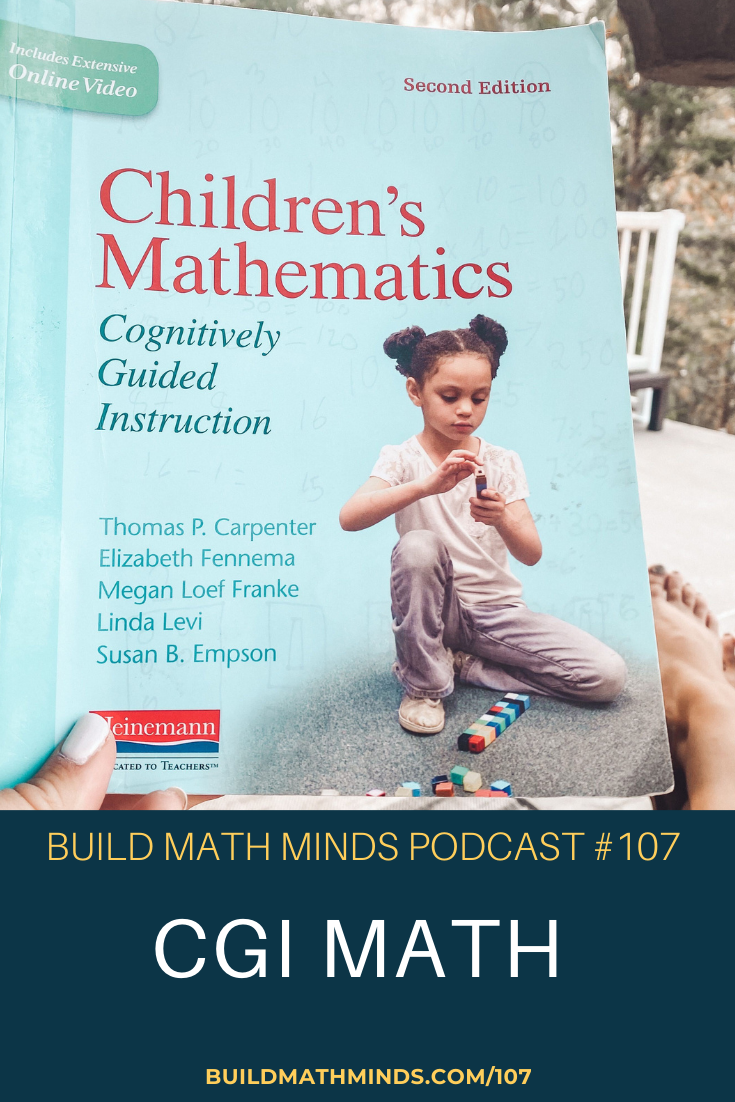Resources mentioned in this episode:
Join the Build Math Minds PD site
Episode #1 – Cognitively Guided Instruction
Episode #27: Using kids intuitive math reasoning
Episode #61 – The Benefits of Inventing Algorithms
Children’s Mathematics: Cognitively Guided Instruction by Thomas P. Carpenter, Elizabeth Fennema, Megan Loef Franke, Linda Levi, and Susan B. Empson
Welcome fellow Recovering Traditionalists to Episode 107. Today we are talking about CGI Math.
Welcome to Build Math Minds the podcast, where fidelity to your students is greater than fidelity to your textbook. I’m your host, Christina Tondevold, the recovering traditionalist and BuildMathMinds.com Founder, where my mission is to change the way we teach elementary math to our kiddos. Are you ready to start building math minds and not just creating calculators? Let’s get started.
Yes I’m once again going to talk about CGI Math (Cognitively Guided Instruction) because it really is one of the foundational things that changed my perspective on learning mathematics
and changed my teaching of mathematics. I’ve talked about CGI Math on three previous podcasts, episode #1, #27 and #67.
I wanted to talk about CGI Math again because I’m re-reading the book right now. Inside the Build Math Minds PD site that I run, we are doing a book study for the members with the book Children’s Mathematics: Cognitively Guided Instruction by Thomas P. Carpenter, et. al and as I started into the Introduction chapter a specific section caught my attention.
On page XIX they write:
“…we do not provide specific directions for how to organize a classroom or how to implement instruction. Teaching is a complex problem-solving endeavor. Because of the intimate knowledge that you have of your own students, you are most qualified to make immediate decisions about supporting your students’ mathematical learning.
That said, in the fifteen years since the publication of the first edition, we have learned a great deal about what classrooms look like when teachers’ mathematics instruction is guided by children’s thinking. We now have much more explicit knowledge of features of successful Cognitively Guided Instruction (CGI) classrooms than we did when we wrote the first edition, and this is reflected in two new chapters on classroom instruction. It is not easy to describe a typical CGI classroom because each one is unique. Our goal is not to provide models of classroom instruction to serve as a template for you to apply to your own classroom. Rather, we present specific cases that embody first principles of successful CGI classrooms. Our goal is for teachers individually and in collaboration with other teachers to make sense of the principles in relation to their own classes and teaching styles.”
I think this is the hardest part when you are a Recovering Traditionalist: not having a step-by-step guide to base instruction off of.
I am, by my nature, a good rule and steps follower. So using a textbook to teach was very natural for me. It told me what to say, what to do, even what the students might say. It was something I could follow. But as a Recovering Traditionalist, you are trying to facilitate your students’ learning and that can’t be scripted.
It can’t be scripted because the group of kiddos you have each year is different. They have different learning styles, they come to you with different experiences, different levels of understanding, etc.
Cognitively Guided Instruction helps us learn how to facilitate the development of kids’ math understanding by listening to the kids first and then making instructional decisions based upon what you hear. Now that’s a very simplified version of what CGI Math is, but this is a short podcast. So if you want to learn how to do that, get the book.
For those of you listening who are members of the Build Math Minds PD site, this is the book we are doing our book study on starting next week and I can’t wait to dig into this book with you. If you aren’t a member, you can come join us by enrolling at buildmathminds.com/bmm. One of the benefits of membership is that we send the book to members. If you join now, we won’t be able to send you the book because we already sent them out but you can still join us for the book study and you can participate in the future book studies we do. Children’s Mathematics is one of 3 books that I credit for helping me change my teaching practice. I love this book and I know you will too.
This episode is brought to you by the Build Math Minds Professional Development site. It’s an online site full of PD videos designed specifically for elementary teachers to help you build your math mind so you can build the math minds of your students. If you are interested in getting in depth math PD at your fingertips become a member of Build Math Minds. Just go to buildmathminds.com/bmm. Depending upon when you’re listening to this, enrollment might be open or you can join the wait list and get notified when it opens again.




